
|
|
|
Check these out    Do you have an entertaining or useful blog or personal website? If you'd like to see it listed here, send the URL to leon@pawneerock.org. AnnouncementsGive us your Pawnee Rock news, and we'll spread the word. |
Too Long in the WindWarning: The following contains opinions and ideas. Some memories may be accurate. -- Leon Unruh. Send comments to Leon November 2008The best game on earth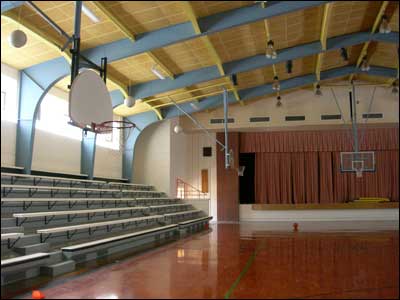
The home side of the Pawnee Rock gym. [November 30] Remember the first time your parents took you to a basketball game in Pawnee Rock's gym? I bet it was a high school game, and as soon as you pulled the front doors open you smelled the popcorn and heard the excited talk of the crowd and you knew that this was something special. Your dad or mom bought the tickets at the window; you may have been so young that you didn't need a ticket or maybe it cost a quarter. You walked in front of the town -- the pep club in the first section, then grownups, and finally mostly kids in the far section -- as you looked up for friends to sit with.
Maybe when Barton County Community Junior College opened, you went to see games there, too. This was big basketball in a big gym. For many high schoolers, this was our first exposure to the college game with its taller players and 20-minute halves -- and it was the first time that the home team wasn't all from one town and you cheered for players you didn't personally know. And now you may have moved to the city -- Hays, Wichita, Lawrence, Dallas -- and you realize that although you once were a starting guard for the B-team you wouldn't have had a chance of making the squad in what is now your neighborhood's school. You had your glory days in your hometown -- where it mattered. It wasn't all fun, although it made you better: The endless wind-sprints and figure-eight weaves in practice, the slap of the pebble-skinned ball on your fingertips, the sweat; you bore the bellow of Coach Romeiser on the bench and Lynn Welch in the stands. You remember how self-conscious you were the first time you went to the free-throw line and realized that everyone in the stands was watching you. You recall nodding to Bob Hemken just before the opening tip against Hanston and he tapped the ball hard so you could take it on the run like Bob Cousy and make a left-handed layup in the goal next to the stage. And at every game you have gone to since graduation, even the KU games when you stood at the front of the student section and the NBA games when you sat in the nosebleed section, you are part of the game because your wrist snaps when you shoot and you protect the rebound by holding your elbows out. You close your eyes and the Pawnee Rock crowd cheers your basket. You think of the way your high school team responded to the full-court press and the 1-3-1 defense. You five were a living organism, swarming and rotating and adapting and always putting the team before yourself. And then comes a day like yesterday, when you take your kid to a college basketball tournament. You sit way up in the cheap seats, at scoreboard level, and you watch the home team come from behind to beat Louisiana Tech. You watch the game, and you watch your son. At first he compares basketball to the sport he knows best, auto racing, but then he eats more popcorn and slips into the swing of the game. You tell him what's going on and why there are free throws and three-point shots, and he gets it. He can shoot hoops with you in the back yard, but this is different and maybe better. You know that you'll never have your glory days again, and you realize that your son won't have the same basketball opportunities that you did. Even though he will never understand everything that basketball means to you, he sees how you love the game, and maybe that is what he'll remember most.
The Great Alaska Shootout consolation bracket: University of Alaska Anchorage vs. Louisiana Tech. Merry Christmas[November 29] I realize that my complaint reveals me to be a fuddy-duddy, but didn't there used to be a time when people had too much to do to stand in line to buy electricity-guzzling $600 television sets on the day after Thanksgiving? I don't remember my mom ever leaving home at 3 a.m. so she could drive to Larned and be first in line at Wards or Duckwalls. No Christmas gift -- even for her beloved daughter and son -- was worth that kind of behavior. People now see pushing into a Wal-Mart and other discount stores as a pleasurable sport. Some of them are in New York, where hundreds of greedy shoppers pushed through a Wal-Mart door and stepped on a worker because he stood between them and whatever made-in-China item they coveted, and they killed him. When's the season for that reason? Surely that wouldn't happen in Kansas. Surely nobody raised in Pawnee Rock would behave that way. Just as surely, nobody from Pawnee Rock would shoot an enemy or two in a toy store. But there are people like that, and days like yesterday make me glad that Pawnee Rock is 1,481 road miles from Valley Stream, New York, and 1,248 miles from Palm Desert, California. Pawnee Rockers' shopping choices then and now are a lot simpler than the ones found in the cities. Maybe that's a good thing. People want what they see, and greed makes people stupid. How does anybody -- including chains like Wal-Mart that encourage "blitz" shopping -- justify the craven madness that has come to symbolize the Christmas season? Give me my fuddy-duddy days when the Christmas tree was bought and put up a week or two before Christmas. What used to make Christmas special, in the sectarian sense, was the sheer pleasure we had in preparing for it at the end of the year, not beginning the moment Halloween ended, and giving a gift we had put some thought and yard-mowing money into. Newspaper and TV companies, which depend on advertisers' money, go along with the multinational corporations and instruct us to save our economy by frittering away our earnings: We must buy clutter so that the people who sell clutter (and advertising) won't lose their jobs, and we must buy it now. But what if you and I don't? What if we acted like Christmas was a joyous, thoughtful occasion? The different land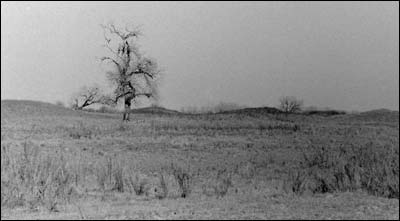
[November 28] As a kid, I spent a lot of time on solid ground, especially on the rolling limestone hills north of town and on Pawnee Rock itself. Even in town, we had real dirt that hurt when you fell on it. But there's a whole other world south of the Arkansas River, inside the big bend where centuries of flooding have dropped Colorado's finest sand. It's not especially good soil for crops, so it tends to go to pasture, and that preserves its natural allure in a state that has been sectioned and farmed almost to death. This is where I have seen the most deer and turkeys, coyotes and raccoons. Snakes and tortoises are welcome here. And yet we treat it like, well, dirt. Our town's dump was not far from here, in the porous sand. There's always the knowledge that the Arkansas and Pickle Creek will flood again, and the Bible instructs us not to build our house on sand, but I think a home in the sandhills would be as good as it gets. Besides football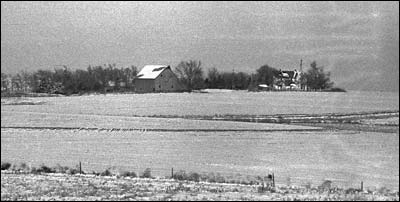
[November 27] Those of us who will be at work today can give thanks that there are three pro football games to watch out of the corner of our eye. Those who have the whole day for the holiday will enjoy the games a little more, I suppose, having eaten their fill of turkey and pie and flopped out in the easy chair once the relatives have taken their pie tins and gone home. My sister, Cheryl, has published a dandy remembrance of Thanksgiving in the Emporia Gazetta. The farm she writes about is in the photo above. (Photo of a holiday meal.) A former colleague of mine, Kim Severson, is blogging her way through her preparations for the Big Meal. She's a food writer at the New York Times, and her kitchen may be smaller than yours. The thing that jumped out at me is that she bought her turkeys from a ranch near Lindsborg. If you're caught off-guard and asked to give the blessing at today's meal, I'd like to prompt you: • Your relatives. And, Readers, I'm thankful that over the past year you have visited PawneeRock.org. I'm glad so many of you have introduced yourselves. Thank you for your ideas and contributions, and just for being there. I'm grateful for you all. Ken Showalter dies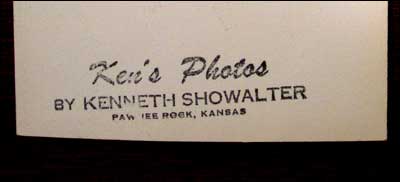
[November 27] Ken Showalter, who photographed us in school and at meetings and during weddings, has come to the end of his life. He died November 21 in Canon City, Colorado, where his son David lives. (A granddaughter, Deana Roberts, lives in Pawnee Rock.) (Obituary) Ken and his wife, Glenna Pauline, had a nice bit of farmland southeast of Pawnee Rock, a little closer to Radium, off the blacktop road that led south from the Darcey farm to the O'Rourke Bridge road. I watched Ken closely and modeled my photography after his. When he posed a large crowd, I noticed his gestures and what he said and how far back he stood and how he climbed a ladder before raising his 4x5 camera -- and left a lot of the close-up bossing to Mrs. Showalter. I created a rubber stamp and marked the back of my prints not with Ken's Photos but Leon Unruh Photo. I hope he had a good life after he retired; it certainly was a long life. He died having just turned 96. Aside from the memories he leaves with his friends and family, his legacy is found in thousands of newspaper clippings, school yearbooks, and photos tucked away in our homes. Indian corn
[November 26] This autumn, to my wife's consternation -- "What are you going to do with that?" -- I bought three ears of Indian corn. They sit on the kitchen counter, cheerfully awaiting Thanksgiving and perhaps reminding the boys of the holiday's tradition. The secret of the corn, however, is more personal. Let me take you to my childhood in Pawnee Rock.
In it were my old coins, Kentucky coffee beans from our yard, a few .22 rounds, my best polished rocks, my first Boy Scout insignia, and the silver medal on a chain that our medley relay team won at Otis-Bison when I was an eighth-grader and ran the anchor leg for the only time in my life. It held notes from girls and a bronze mouthpiece adapter for my trumpet. But most importantly, the middle drawer on the bottom row held kernels of Indian corn. Those kernels, with their minute bands of color, were as fascinating as river agate. On winter nights I sorted them by color, by off-color, and by size, and I marveled that anything could grow so beautifully. I don't know who gave me the corn; perhaps it was my mom's parents, who had a way with gardening and maybe thought that interesting genes ran in the family as well as the corn. Ever since those Pawnee Rock days, I have longed for Indian corn and I'll save some of these kernels for my second childhood. If everything goes right, a few kernels will also sneak their way into our sons' treasure drawers.
Honk if you love geeses[November 25] The sound of geese is one of my favorite heralds of autumn. Finding the birds in flight is a thrill I don't think we ever get tired of. The sound comes before we see the birds, and we spin ourselves around until our ears and eyes agree on where the geese are.
Sandhill cranes use the central flyway as well, honking out the front and dragging their long legs behind them. Geese and cranes have been making these trips north and south for millennia, and they have the route down. Now and then, humans with shotguns get in the way, and once near Macksville I found a crane that had its goose cooked simply because it got a powerline either twisted around or driven into its neck. How that happened remains a mystery of nature. The roads within us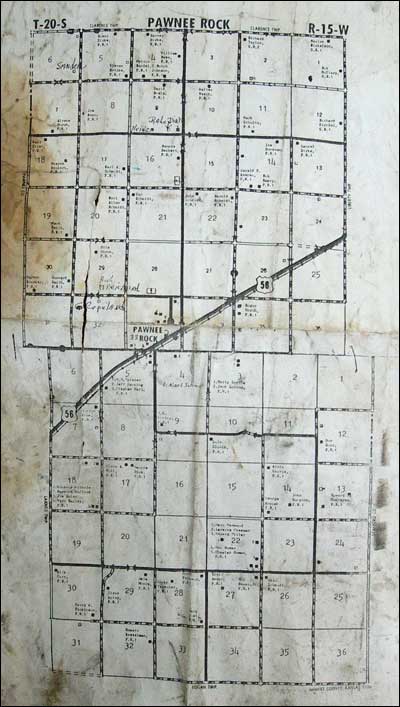
[November 24] As has every Pawnee Rock kid who read Robert Louis Stevenson's "Kidnapped," I daydreamed about being abducted and then escaping into the wilds. The "wilds" of my small imagination usually was the rolling dryland north of Pawnee Rock. From anywhere out there, finding my way home was not a problem. Any kid who spent much time outdoors would find it just as easy to get oriented. The roads run north and south and east and west. The trees are bent one direction, so it's always clear which way is south, and if you know south you know east and west and north. If it's in the winter and snowy, the sun is far south and the drifts overhang the northern ditches. You know that if you walk north or south that you'll come to an asphalt road you can follow to a town or highway. So it was easy to figure out where I was pretending to be, and I got bored with that game. Our part of the state is just that way -- cut squarely and efficiently with the apparent intention of taking all the surprise out of travel. Except along the river and creeks, there's almost no variation in the template. (Draw your own conclusions about the people who are raised in such a landscape.) I never get lost west of the Kansas Turnpike. There are just so many clues. But put me in a strange land, where the roads go around the hills and side roads lead off other side roads into wooded hollows, and it's another story. Yesterday at midafternoon, not long before sunset, Sam and I set off to deliver some DVDs of dog-mushing photos of Jeff Deeter to his parents, who are a delightful and impressive artist and poet. We drove up the highway, around Knik Arm, then into Wasilla, then seven miles up an off-kilter road and a couple of miles on another road over forested hill and dale to another byroad, and theirs was the third house on the left. This doesn't count my errant crossing of a small river or the rescue-me call I made from a hilltop churchyard. (Now that I know where their home is, however, I'll never miss it again.) With its twisting gravel roads that slink past lovely bogs, the residential area north of Wasilla is a great place for the artistically minded: birch forests, a river, lakes, and the old mountains rising in the near distance. My friends, who previously worked in more exotic places, moved into that neighborhood because they wanted their son to have a "Huck Finn" childhood. I suspect that people who are raised in that area learn the roadmap as they grow up rather than have an innate sense of the geography, but it's also possible that they're keyed in to subtle changes in the altitude and plants that I miss. That broader area is also, as we read in our newspaper now and again, a landscape that makes casual breaking of the law easy and that may even encourage the willful acceptance of ignorance by those who choose to live in the shadows. Yet, who am I to point a finger at them? Without a map, I can hardly find my way through their warren of roads and hidden driveways. This would be a much more exciting place to set my own "Kidnapped" story. Perhaps it is good for many of us that we were raised in the part of the country with order-inducing maps. No matter which road we choose, in life as in Kansas, we figure out early on where it's going to take us, and after every mile we can pick a new direction. Was there a doctor in your house?
Pawnee Rock apparently had several doctors and a handful of drugstores, which would include both what we think of as pharmacies and stores that sold patent medicines. Do you remember the names of doctors or dentists in Pawnee Rock? I'd like to give them due recognition for keeping you or your parents and grandparents alive. Or, if any of them were scamps and rogues, that would be useful to know too. Please let me know. Open, sesame[November 23] Maybe your family was different, but ours (and my grandparents') fried foods in Crisco or Wesson Oil. I moved on to olive and canola oils, both for the taste and to keep my veins clear, and I was especially happy with olive oil's flavor and exotic connotations after friends in New Orleans showed me how to drip it onto a plate and dip bread into it -- the same way my dad used to clean bacon grease off the platter. My son Sam likes to cook, so last week I bought him a little book of easy Chinese recipes. He and I went down to the grocery and bought stir-fry sauce, hoisin sauce, chili oil, and sesame oil for frying. Sam fixed stir-fry soup, which no doubt will become a household favorite. But the big news for me was the sesame oil. I now have a name for the scent that reaches all the way into me, and three times yesterday I opened the lid just to smell the oil. It's better than perfume, even Magic Noir. I might have stayed down on the farm if the chicken had been fried in sesame oil. The other side of November 22[November 22] Ten years ago today I traced the path taken by Lee Harvey Oswald immediately after John Kennedy was shot. It was my day off and the 35th anniversary of the assassination, so I went for the dozenth time to Dealey Plaza, just three blocks from the newspaper where I held a job. I toured the Schoolbook Depository and looked down onto Elm Street, although the live oaks had grown and changed the view. I stood where Abraham Zapruder had pointed his movie camera at the limousine, and I walked on the grassy knoll. At that point, I joined up with David Leeson, a friend and photographer from the Morning News -- in Kennedy's time a virulent and hateful opponent of the young president -- and we drove south into Oak Cliff, the part of town across the Trinity River south of downtown. We saw where Oswald shot Officer Tippett, where Oswald lived, and where he went to hide in the dark as the police crawled through Oak Cliff looking for a cop killer. We paid a small fee and went into the Texas Theatre, where Oswald was finally arrested. We took turns sitting in his seat, now dressed in black, and watched a few moments of "War Is Hell," the black and white movie Oswald saw. We were practically alone. We had left everyone else behind at Dealey Plaza. For many people, the assassination is all about the Kennedys and the legend. But it was important to me to get a feel for the world of the killer. A year later, I went to Fort Worth's Rose Hill Cemetery, where Oswald had been buried after being killed himself. He was later exhumed so people could make sure it was him, and then he was reburied in an unmarked grave. I was completing a circle of sorts, or following a line to its end. Of course, it was more than that. It was how a small-town guy tried to see in a new way the things he had learned since he was a first-grader 35 years earlier in Pawnee Rock. Stay, Buddy![November 21] I like what Dana Hines had to say about our wayward dog Buddy: So happy Buddy's escape had a happy ending. Here's to hoping he learns his lesson. Sam did a great job of using "doggie-psychology." I guess animals aren't so different from many people who wonder what lies out there in the "way beyond" -- kind of like our Kansas roots, especially our small-town ones. Sure, there's probably something a lot more exciting out there, but nothing beats the warm embrace of loved ones welcoming you home! John Wise and family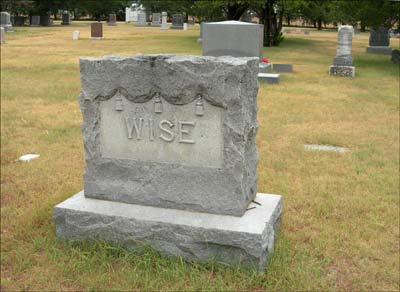
The Wise family now rests in the Pawnee Rock Cemetery under one of our more interesting stones, the one with the drapes and tassels. Along with John and Mary, there lie five other Wises. [November 20] John Wise and his wife, Mary, settled south of Pawnee Rock in 1874, just a couple of years after our hometown was born. He was a veteran of the Virginia Calvary, a Democrat and a prohibitionist who, rarely among people of his day, seemed to enjoy posing for a photograph. The following biography came from "A Standard History of Kansas and Kansans," written and compiled by William E. Connelley, secretary of the Kansas State Historical Society, published in 1919. There's quite a bit of pre-Kansas history, but the second half provides a good look at life in old Pawnee Rock. Nowadays, Larned Township, where the Wises set up their farm, is a 6x6-section block that starts at the southwestern corner of Barton County, but in 1878 the township was an irregular mass that followed the highly desirable Arkansas River and Ash Creek bottomlands. So, I don't know exactly where the Wise farm was -- but perhaps a reader who knows can relay the information. The farm may have been directly south of Pawnee Rock, or southwest. 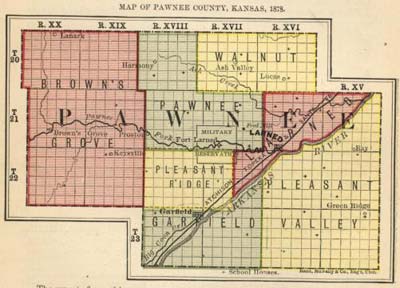
Pawnee County townships, 1878 JOHN M. WISETo say that a man has lived in Western Kansas over forty years is to classify him without further description as one of the true and original pioneers. It was in the month of October, 1874, that John M. Wise arrived in Pawnee County. If there is any feature of frontier experience which he has not learned by personal contact he does not know of it. He was introduced to this section of the state about the time the grasshoppers were performing their widespread scourge. He has seen the very driest years, seasons when grain would not even sprout, times when the grass withered and parched on the prairies, and when it seemed that no living thing could survive. Somehow he contrived to stay, to endure the worst and enjoy the best, and in later years he has not had to deny himself or his family any of the real comforts and conveniences.
Samuel Wise, father of John M., was a native of Pennsylvania, and when his son John was a child moved to Frederick County, Virginia, where he followed farming and blacksmithing. Though he had only a modest education, reading, writing and arithmetic, he possessed much energy and ambition, and always managed to live well and provide for his family. He was born in 1811 and died in 1876; at Madison, Alabama, where he spent his last years. Late in life he became a member of the Methodist Church. In politics he began voting as a whig but after the rebellion was a democrat. Samuel Wise married Sarah Line, who also died in Madison, Alabama. Their children were seven sons and one daughter: Sarah, who married James H. Cantor and died in Frederick County, Virginia, and is buried at Winchester; Samuel, who died at Hillsdale, Oklahoma; John M.; William, who died at Beaver, Oklahoma; David, who died in Frederick County, Virginia, in 1862; Henry, a carpenter in Frederick County; George, a merchant and president of the bank at Madison, Alabama; Arthur, also a merchant at Madison, where he died. John M. Wise spent his early youth in the picturesque and beautiful Shenandoah Valley of Virginia. He had a good home, attended the country schools, and for a time was a student in a college at Winchester. He became a member of the Cadet Corps there and acquired considerable knowledge of infantry tactics and drill. Thus he was not completely a raw recruit when in April, 1861, he enlisted for service in the Confederate army. He became a member of Company A of the First Virginia Cavalry. His captains were successively Drake, Lock and Trussel and his first colonel was the great cavalryman J. E. B. Stewart. Later he was under Col. W. E. Jones, Col. Fitzhugh Lee, Colonel Drake, who had been promoted from captain, and finally under Col. W. A. Morgan. The First Virginia Cavalry rendezvoused about Manassas, where the first battle of Bull Run was fought. Mr. Wise saw his first actual fighting around Richmond and during the Peninsula Campaign of 1862. He was in all of the Seven Days battles, ending with Malvern Hill on the James River. Following this campaign the regiment went into Maryland, was in the battle of Antietam, and subsequently covered the retreat of the army into Virginia. He fought at Fredericksburg, in the battle of Chancellorsville, and was in the three days' fight at Gettysburg and was slightly wounded on the last day. The regiment then wintered at Bowling Green, Virginia, and the spring opened with the Wilderness campaign. He was at Spottsylvania, and from there the regiment was sent after Sheridan's forces and fought the battle of Yellow Tavern, where General Stuart was killed. He was in the operations around Richmond and the Petersburg Campaign. General Fitzhugh Lee succeeded General Stuart and the Lee Corps joined the Early forces in the Valley of Virginia. Mr. Wise was in the historic and memorable campaign of the Shenandoah Valley and in the battle of Winchester. His regiment then saw active service during the concluding scenes around Richmond and the retreat to Appomattox. The First Virginia Cavalry was part of Lee's diminished armies that surrendered. They were well out to the edge of the army at the time, and when Mr. Wise and some of his comrades witnessed the approach of a Union officer with a flag of truce and suspecting the surrender, he and others left the command and did not surrender at the time. Mr. Wise's first purpose was to seek General Johnston's army in North Carolina and continue the fight. However, when he learned of the generous terms of surrender offered by General Grant, he went back home, surrendered and was paroled at Winchester. Four years of warfare had left devastation and ruin in their track. The Shenandoah Valley where he had passed his boyhood was a very different country from what he had known before the war. Mr. Wise, like many other Southerners, made the best of the situation. He had his old army horse and a few animals that might properly be described as "plugs" he used to make his new start in life. For a time he raised corn and potatoes, and gradually built up a stock of hogs. The spring of 1865 came very early, the grass grew luxuriantly, and it seemed as though Providence was kind to the war stricken kind. Mr. Wise remained in Virginia until the spring of 1874, when he took his family to Alabama, where his parents then lived, and in the following fall came to Kansas. He arrived in Pawnee County by railroad and brought with him his wife and two children. His possessions on arriving in the state were household goods, clothes and bedding and about $400 in cash. Leaving the train at Pawnee Rock Mr. Wise pre-empted the quarter section of land where he now lives in Larned Township. It is the northwest quarter of section 12, township 21, range 16. Subsequently he homesteaded eighty acres of this. His first home was built of frame, 12 by 18 feet, a story and a half high. There was also a temporary shelter for his yoke of oxen and pony. The oxen pulled the plow for the breaking up of his land and for other farm work, and occasionally were hitched to the vehicle which conveyed the family to church. At other times the family walked to attend church services at Pawnee Rock, and it is Mr. Wise's conviction that all of them enjoyed the sermon as much as if they had come to the House of God in an automobile. Mr. Wise came from a great fruit section, and naturally he attempted to improve his land with an orchard, but his trees were subsequently ruined by a hail storm. He also bought a couple of cows, and as rapidly as possible he developed a herd of live stock. Stock raising has always been an important feature of his enterprise, but for years there was little profit in it because of low prices. He soon discovered that Pawnee County was a pre-eminent wheat growing district. But he was unable to engage in wheat raising on an extensive scale for some years. This was due to the fact that he had a limited acreage, and he could not buy additional land until about 1882. Since then his purchases of land have been somewhat more frequent, and all of it has been bought and paid for through his industry and his farm products. He now owns three quarter sections and an eighty. His farm is bisected by Ash Creek. In contrast to the scenery to which he had been accustomed as a boy in Virginia Mr. Wise naturally noted the almost complete absence of timber in the early days in Pawnee County. One or two small bushes growing along the creek made up all the shrubbery in evidence. Since then he has developed by planting and cultivation sufficient timber for farm use. He set out many cottonwoods in the early days, chiefly for shade purposes, and these trees are now fit for saw logs. Besides what he did do through his individual industry Mr. Wise also co-operated with his neighbors in establishing local institutions. He helped organize the school district and he was chosen to teach the first term of school in the little frame schoolhouse of district No. 9. He has almost continuously served the district in some capacity as clerk or director and is now its treasurer. He was also elected justice of the peace. He was elected and qualified for that office before his political disabilities as a former Confederate soldier had been removed, and he forgot entirely that he was not a citizen in the eyes of the law. He also served as township clerk. In national politics he has generally voted democratic, though he has been a very ardent advocate of prohibition. It was his support of that cause which made him an active adherent of St. John for governor. He takes great pride in the prohibition record of Kansas. The recent state and national enactment extending and emphasizing the prohibition principle has caused him very sincere pleasure. On coming to Kansas the family became Presbyterians and now hold membership in the Larned church. Mr. Wise was married in Frederick County, Virginia, February 15, 1870, to Miss Mary Virginia Hale, who was born there May 6, 1851, daughter of Lewis W. and Mary (Emmett) Hale. Her father was a native of Frederick County and spent his life there as a farmer, dying when about seventy-eight years of age. Mrs. Wise's mother died in 1852, and she was one of two children, her brother being Lewis E. Her father married for his second wife Sarah Whissen, whose children, John C. and Mrs. Henrietta Stimmel, both live in Frederick County, Virginia. Mr. and Mrs. Wise have three children: Emmett, an employe of the Trinity and Brazos Valley Railway Company, living at Fort Worth, Texas, married Nora North; Sarah is the wife of Edwin A. Smith, of Pawnee County, and has a daughter, Virginia; Bernice H., the youngest child, graduated as a member of the class of 1918 in the Kansas State Agricultural College at Manhattan, is a high school teacher at Carbondale, Kansas. A handful of dog
Buddy the errant husky in his younger but no less happy days. [November 19] I lost our big dog last night. His leash got tangled with the beagle's as I walked the dogs, and Buddy slipped out of his choke collar and dashed into the dark snowy forest. He's 70 pounds of knuckles and lightning, and he was bred for pulling dog sleds. He's far too quick for me, and he's too happy, to use a polite word, to know that he should stay off the road. He's done this before. Each time, I'm reminded of my little dog Patches, who was my pup when I was in grade school in Pawnee Rock. Patches could have fit into a quart measuring cup when we got her from Rita and JayDee Schraeder. They lived with their folks at the intersection of Santa Fe and Houck, a block and a half west of our place. Patches, named for her brown spots, was a mix between a chihuahua and a rat terrier. A boy offered a puppy is not concerned with a pedigree or size if the puppy licks his face. I carried Patches home to show Mom and downtown to show Dad at his shop. I carried her around our house, and in our house. I wanted her to sleep with me, but Dad had other ideas. Cursed by his farm upbringing, he insisted that dogs sleep outdoors, so I fixed up a box under the back porch and put her out that night to whine herself to sleep -- her first night away from her mama and brothers and sisters. The next morning, I dashed out to collect my dog. She was gone. She wasn't in the back yard. The gate was shut, so she couldn't have wandered out the front. I was a very sad boy. Then the Schraeders called. My little pup had slipped through our picket fence and reappeared at the only home she knew. Had her mother been calling her? Had Patches followed her nose home? Had she wandered all over the neighborhood before finding the right house?
Now there's Buddy, whose enthusiasm for speed and freedom greatly outweighs his common sense. And there's Sam, Buddy's owner for five and a half years. He expects the worst when Buddy dashes off. Buddy has had narrow escapes on the busy road near our neighborhood, and the last time Buddy was footloose he ran into the side of a moving truck and got tumbled but was unhurt. Sam bundled himself up and came out to help, and we tried a different tactic this time. Instead of chasing Buddy, we let him know we were ignoring him. Finally, Buddy got tired of the cold and came to a handful of treats Sam had tossed down on the street. Sam sidled over. With his gloved hand he grabbed Buddy's collar, and his smile lit up the street. He had saved his dog. Art over the back yard[November 18] There was a period in the 1960s when Pawnee Rock fell under the influence of purple martins. Those big sparrows were going to save us from mosquitoes, the legend went, and so every handyman and carpenter built an apartment house for purple martins and put it high above the yard. Our dad, Elgie, was the town's carpenter and built a beautiful birdhouse. It was, if my memory is correct, painted the color of iron rust. The martin house was perched atop a pipe in a flower garden next to the water pump. I sat out there for minutes at a time, hoping to see the birds with the beautiful name. The grownup Unruhs and their friends, constitutionally suited for sitting for much longer, probably enjoyed the birds a little more, but I admired birds and used crayons to color pictures of them.
Dad, who as you may remember was the king of cobbling junk together, never got over the old days -- his old days -- and he built a weather vane for our yard. I think a number of old boys who were raised on farms had them, and you might still find one or two in town. The vane fascinated me with its simplicity. Like any kid in Pawnee Rock, I could read the wind in the trees and clouds, but we had a tool that made the wind direction "official." Our house and big elms blocked the southwest wind on our double lot, but when it really counted -- when the north wind came -- we justified our shivering by telling each other what the weather vane said. It was almost certainly because of Dad's weather vane that I started the Unruh Weather Forecasting Company when I was in fifth or sixth grade. I kept wind and temperature records; with Mom's help, I created a barometer from a bean can, a balloon, and a straw; and on top of a mound of garden dirt I set up a lightning rod that I had created from a length of thick wire, some floral wire, and a flashbulb (for proof that the rod had been struck). For Dad, the weather vane was a look backward. For me, a youngster with very few years behind me, it was instead a pointer toward a lifetime fascination with weather statistics. The weather vane was gone in 2005 when I last photographed the back yard, but a birdhouse -- maybe it's the same one -- rested atop a hefty post. Now I wear the geezer shoes. Like Dad did, I remember the decorations of my childhood, and the thought makes me wistful for the yard where I grew up.
The back yard in 2005. The weather vane rested atop the pole on the right. The trill of it all
Bach wrote out a primer of trills in 1720 for his son. This snippet of artwork came from a copy posted on this smart site.
[November 17] I just finished a New York professor's 190-page book about the 100 or so trills -- warbles lasting a fraction of a beat -- in the Cello Suites by Johann Sebastian Bach. Now, you and I might have enjoyed entire, happy lives without discovering that such trills existed. But then we would never have known that there are several varieties of trills, depending on such things as whether (a) the preceding note is above or below where the trill starts or (b) whether it starts before or on the beat or (c) whether it is marked or not on the sheet of music. This isn't the world's only book on an esoteric subject. Look through any bookstore, and you'll find experts on all kinds of things. What matters is that there's curiosity. The author has enough of it to make writing a book about an obscure topic his guiding force for months, if not years. And we, the readers, are willing to spend money on such a book and then spend time appreciating it. In my case, I listened to a bunch of my Bach recordings and haunted the iTunes store to find those elusive trills -- something I never would have noticed before but now something I'll listen for every time I hear cello music for the rest of my life. The improvement comes not because I live for cheap trills, but because I'm clued in to the fact that they exist. Knowing about the trills will not add measurably to my financial status or make me the hit of the office party, but I'll know something I didn't know last week. I'll gladly share my new knowledge of tricks one can do with a cello. The hard part, I suspect, will be getting somebody to bring up the subject. A sanctuary for photography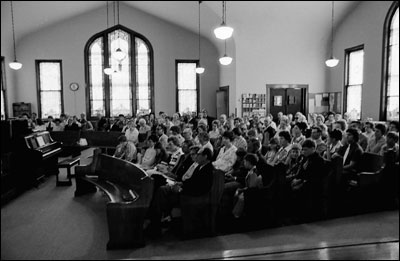
[November 16] Taking photos of the congregation inside the Bergthal Mennonite Church while the Rev. Gerhard Peters was speaking was a one-in-a-lifetime occasion. Rev. Peters was formal, and I hadn't expected to talk him into letting me wander around and clack my shutter. He also was president of the Lions Club one year, and even in that body of ornery men his back was straight. In 1974 the church was getting ready to celebrate its 100th anniversary, the original Mennonite settlers having come to the grasshopper-eaten plains of Dundee and Pawnee Rock by steamship and train from southern Russia. I suggested to Rev. Peters how nice it would be to have photos of the congregation in the pews, a sort of "action" photograph. In photos of earlier congregations, the members had been lined up outdoors across the front of the church.
At the time, the photos were a sort of trophy and I was glad to contribute to the church, which after the school was the second-most important community in my life. As I was too shy to ask everyone to pose individually, it was a big help to have Rev. Peters hold them captive, and now we have a record of our ancestors and a memory aid for those of us, like me, who haven't been in the church building since our grandmother died. I'd like to point out a few things about these photos. First, Rev. Peters asked everyone to sit in the main sanctuary; a number of families, including ours, usually sat off to the south side of the pulpit. He wanted the church to look fuller, and it served the additional purpose of getting more faces in the photos. Second, I find it amusing that no matter how full the sanctuary was, nobody sat in the first pews. I assume that's because everybody, subconsciously at least, wanted a barrier between themselves and the preacher/God's word. Also, I don't think anybody would have dared upset the social order by sitting in front of the Roland Schmidts and Earl Alvin Schmidts. And, as I remember it, many of the old farmers sat in the far corner behind the organ. The widows sat in the back at the far right. The pews where the old folks sat were wired for sound; the hard-of-hearing could hold little black paddle-shaped speakers up to their ears when they wanted to listen to the sermon. When I was a teenager, having these photos "tamed" the church for me. Even though I grew up in this church, there were many people I didn't really know beyond what it took to shake their hand at the door. For years I had stood before them on the stage, singing in the youth choir or playing my trumpet or speaking parts in the Christmas program, and they were patient but dark and unsmiling faces backlit by the big windows. These photographs gave me a sense not of mastery but of "evenness" with them in that I finally could look into their faces and sort them out in my own way. Irma Hackerott dies[November 16] Irma Marie Leitschuh Hackerott died Thursday at the hospital in Hays. She was the wife of Shorty, and she had a great-great-granddaughter. She took pride in being a good waitress and understanding the antique business. (Obituary) Sports time[November 16] The football teams of Kansas and Kansas State universities got pasted to the turf yesterday; it's just like the old days. But now it's also college basketball season. On Friday, K-State beat Florida A&M, and today KU plays the University of Missouri-Kansas City in Lawrence. And Kansas' own NASCAR driver, Clint Bowyer, won the Nationwide series (NASCAR's junior varsity) championship yesterday at the Homestead track in Florida, beating Carl Edwards, a Missouri driver. Bowyer claimed the title in the Kansas way -- he won only one race during the season but consistently finished high enough each week to rise to the top of the standings. Today he races in the season-ending NASCAR Sprint series race. There has been some mention that Clint has ties to Pawnee Rock. I wonder whether he's related to LaVern Bowyer, who lived in rural Pawnee Rock. Summer recreation, 2003[November 15] The Pawnee Rock News on August 7, 2003, recorded details of a trip that wrapped up the town's summer recreation program. From Summer Rec Director Tricia GalliartJuly 31 was the final day and night for summer recreation. Thirty-two children and nine adults drove to Hays Water Park and enjoyed afternoon swimming ending with pizza in the Park at Hays. On the return to Pawnee Rock they erected tents and enjoyed an overnight camp-out in the Pawnee Rock Park. They had an awards ceremony for activities completed during the summer and afterwards had a hay-rack ride (courtesy of Johnny Schmidt -- Thanks!) around the town and countryside. There were 21 brave campers who endured the stormy weather and enjoyed doughtnuts and juice in the morning with their adult sponsors. Thanks to the following people who drove to Hays: Konny Ritchie, Joyce Link, Berny Unruh, LeAnna Unruh, Sherry Johnson and Phyllis Agee. Also thanks to other drivers during the summer -- Chris Derryberry and Trimmer Family. Submissions: Another paragraph in the Pawnee Rock News shows how easy-going life can be in a good town: To put something in the next issue of Pawnee Rock News, put it on the window sill at City Hall. Include your signature and phone number in case the editor needs to check with you. Friends, where art thou?[November 14] Towns like Pawnee Rock produce more sons and daughters than the place can support, and so those kids grow up and move to other towns and to cities where the prospects are brighter. We should be used to this by now. Still, it's unsettling to look at a yearbook and realize that I don't have any idea where half of my school class is. These are kids I spent 10 or 13 years with. I do know where a few are. There's the pal who married and moved to Dallas, or was it the other way around? Another classmate lives next door to where I grew up, and yet another lives north of town and works in Larned. A fourth lives in Larned, a fifth in Great Bend, a sixth and a seventh live in Hays, an eighth lives in Garden City, and a ninth sings somewhere near Seattle. But what happened to the others? Did they melt into the spy world? Are they under wraps in the witness protection program or, for that matter, are they gangsters? Did anybody's life lead where we thought it would? A decade ago, the KU school newspaper had a reunion. One of my friends had gone on to writing a column for the Wall Street Journal and another to covering the administration for the AP, but a lot of friends, as one woman who had intended to become a magazine editor put it, "got married and had contentment forced on me." People who have responded to PawneeRock.org have settled all over the country. A few have high-profile jobs, but most of us are what the politicians insist on calling "ordinary" Americans as we chug along in quiet desperation. It is reassuring to know that my classmates are out there somewhere in America -- or somewhere in the world -- and I'm sure we're all doing the best we can with what we have. I like to think, however, that one of my missing classmates is a mathematician at a great university, another is a spy in a world capital, a third runs a thriving business, a fourth is the parent of happy children, and a fifth is a poet in San Francisco. I don't really have to know where my classmates are to be happy for them. I do wish they -- excepting the ones in the witness protection program -- would write and let me know they're doing well. Seeking art on the Rock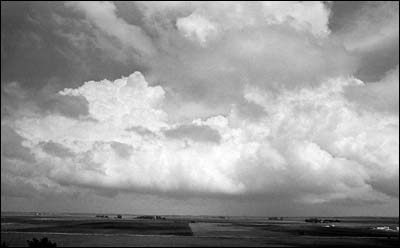
[November 13] Back in the day when I thought I had an undiscovered genius for drawing, I'd sit at the base of the monument on Pawnee Rock and draw the big spire or the pavilion or the yuccas and wait for the summer tourists to gather 'round and applaud my artistry. Sometimes it worked. Looking back at those scenes from the perspective of a father of boys who are about the age I was then, I realize that I was getting praise mostly for my gumption. As the years went by, the Rock still drew me when I was in an artistic mood. In high school and college, I was influenced less by Ruth Deckert and more by Laura Gilpin (see more) and Ansel Adams, and photography was my medium. In every kind of weather -- fog, snow, rain, sunshine, darkness, tornado -- I photographed the Rock and tried to capture the essence of what made it The Rock. I wanted the perfect light. The texture of the sandstone. The glory of the sky. If it were possible to capture the wind, I wanted that too. I've come to understand that I was trying to understand the mystery of what by our generation was a shortened, mowed landmark that nevertheless was the biggest geological attraction between Cheyenne Bottoms and St. Jacob's Well. I wanted to feel the grit of history and to see our countryside as the sunburned wagoneers had 150 years earlier. The Rock and the landscape still fascinate me, an obsession that I imagine is familiar to most everyone who grew up in our hometown or lived there for long. This big scenery is what we have in common, and it could be that what I am looking for amid the clouds and angled shadows is our shared soul. It would be foolish for me to suggest that my artistry has improved, but maybe I'm getting closer to understanding what spoke to me forty years ago. Blog watch: There's a new Western Kansas-oriented blog worth checking out. Stan Finger, a Rozel boy made good, has a personal blog, Words of a Scribe, to accompany his weather blog at the Wichita Eagle. One of his early entries deals with his late father's introduction to World War II. Many of you may have known his dad, Marvin; the family still has a farm along the creek just south of U.S. 156 just this side of Rozel. Also: Cheryl Unruh's column in the Emporia Gazette is a romp through the games and activities created by Pawnee Rock children in the days before cell phones. Thank you for heroic service[November 12] Dana Hines of Tucson was moved by Rick Clawson's eloquent e-mail yesterday about the fuller role of the U.S. military in protecting our country and furthering its goals. Just a huge "thank you" for printing Rick Clawson's letter. I fully appreciate his first-hand insight and opinion, and I love the way he expressed the imperative role of the United States of America's military in the world. I applaud that opinion loud and strong! A tremendous "thank you" to both he and his son for their heroic service to our country, and to those others who have so bravely served in our military, past and present. THANK YOU, and God bless you and the USA!!!!! With gratitude and admiration, Hi, Jamie Clawson-Young[November 12] Jamie Clawson-Young, who grew up in Pawnee Rock, writes to say hello and bring to our minds her family, on whom many of our motorists depended. My name is Jamie Young (would be known as a Clawson in PR). I found the website and wanted to thank you for your time and dedication. I will be joining the friends of it when I have time. I was born in GB and raised in PR from 1971-1989. My grandparents are AB and Doris Clawson (owned the mechanics shop and wrecker service) and my parents are the late Jim Clawson and Barbara. None of us live there anymore, although my grandfather still has property right there off of the highway. I will give more info later for the page, but wanted to say thank you for the site! Sincerely, A veteran's voice[November 11] Rick Clawson read this morning's posting in which I wondered about and admired the bond between the men and women in our military. He wrote to elaborate not only on the service provided in war, but also on why sometimes there is no war. Pay attention -- these are the words of a man who grew up in Pawnee Rock: What the military does for youJust read your post on your web-site about military duty. What makes it what it is? There are many things that people just don't realize what the military does for them. I am a retired Marine and extremely proud that I gave 20 of my best years to OUR country. What does that mean? Well, there are many people in this world who do not experience the quality of life in our country. Yes, France does too, but if you recall they have never won a war. In WWII, the Germans took over France and would probably still be there if we, the U.S. had not pushed them back to the Rhineland. The Berlin Wall came down during the Reagan presidency because communism could no longer lie to the people it repressed, and they had support from the U.S. government/military. And I guess we could also ask, Why aren't there missles in Cuba? Okay, present day. There is peace in the Pacific ... you think. I thought so too. But during my tour of duty in Diego Garcia, I was befriended by a sailor who worked in the weather department. His job was to fly in a P-3 Orion (submarine tracker) over the Indian Ocean as part of his job to check the weather. He told me that contrary to what we see, we really aren't seeing what's going on out there in the big waters. Real issues are there. The Chinese are present in the waters and the games being played are serious. Hong Kong and Taiwan are still free territories because of our visible military presence. The Philippine Islands kicked us out in the early '90s, a prefect vacuum to be filled. Why isn't being filled? The Chinese and Russians know we won't tolerate it. There are a lot of little countries (and big countries) who benefit from our military because we won't allow Russian or Chinese expansionism. If you recall in American history President James Monroe established the Monroe Doctrine, which basically said we won't allow any foreign power to establish foothold in the western hemisphere. We have expanded this doctrine in order to protect our own interests. We are involved everywhere because our interests are everywhere. My son is in the U.S. Air Force and works in a Predator Squadron. Predators are those unmanned aircraft that fly reconnaissance in Iraq, Afghanistan, Bosnia, and many places we aren't told, for security reasons. My son cannot talk about what he sees (he has immediate visual observation of what the Predator is filming) but he does say it is "Real World." In the military that means people are probably dying, or going to die because the choices they have made. For my son, that means it's probably an enemy of our country. Being nice to people is ... well ... nice. But, unfortunately nice also is a sign of weakness. If you look at the countries in Europe who got overrun by the Nazis, they tried to be nice to Hitler and he used it against them. The Jews didn't stand up for themselves and thought if they cooperated with the Nazis everything would workout. It didn't. The Israelis have tried for years to negotiate with the Palestinians, but the Palestinians turn around and use it against them. So, the Israelis are forced to use force to subdue the aggressors, those who instigated the whole deal. It is imperative that we have a strong military, and it must be worldwide. Our country must be involved everywhere. The world is much safer, our citizens are much safer, as is our livelihood. If you flex your muscles you keep the bullies in check. You can negotiate if you can back it up with your military might. If you are weak then you will be in danger. We let our guard down and 9/11 happened. These guys were here in this country for two years, and we knew it, but chose not to do anything about it. We wanted to be nice. Military members understand their purpose and how significant their jobs are, not necessarily each individual job, but the whole product, which is to protect this country and preserve our way of life. It isn't about what action you took, it's about you being there prevented something from happening. We are proud that we ensure that people back home are able to live their lives without worrying about world issues. People worry about mortgages and insurance and medical coverage and the sort, but in the big scheme of things look at people in Africa who are being slaughtered, or how about Sudan where genocide is the reciepe for the day. Or the journalist in Afghanistan who was abducted from the refugee camp. And we could recall Cambodia where 2 million people died thanks to Pol Pot. There wasn't anyone to stand up for those people's rights. Yep, the military is a big deal. Don't let your guy in Washington shortchange the guys in uniform. There will always be a debt to be paid when you weaken your military. Right now, the credit card is maxed out. We are paying, thanks to 9/11, the Cole, and the embassies in Africa. Rick Honor history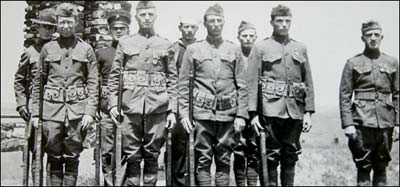
Soldiers pose on the Rock in the 1920s. [November 11] When I drive to work, I see a lot of pickups with veterans tags and Vietnam-ribbon stickers and I wonder what about military service so defines a man's or woman's life that everything that follows revolves around that identity. I wasn't in the military, so I've tried to understand from the perspective of my four years of college. I think about how wrapped up I was in my journalism-school community and Jayhawk basketball games, and I think I get glimmer of understanding. But for all the travails that came with exams and deadlines, no one was shooting at me and my only death threat may have been a hoax. No drill sergeant screamed in my face. My work may have influenced some lives, but nothing I did turned out to be a matter of life or death -- my own or anyone else's. I know, from my reading and from talking to our neighborhood's soldiers, that the artillerymen and combat engineers and door gunners feel a bit apart, and maybe above, those like me, whose major chore each day is driving to work. They're younger, faster, stronger, and able to take care of themselves in any conditions. More power to them. In fact, I do see my newspaper work as important for the First Amendment, but, again, I come home with clean clothes. My broadest exposure to war -- wire stories and thousands of photographs of bodies -- is not something I would wish on my neighbors and sons, but I am far removed from the fear and determination that bonds men and women into that brotherhood who served in the Argonne and Bataan and Chosin and Little Rock and Hue and Iran and Beirut and Grenada and Mogadishu and Bosnia and Iraq and Afghanistan and again Iraq and now Pakistan and Syria and untold battlefields behind the curtain. Today we remember the men and women who have given their lives in our country's military service. We do that to honor history, but let's not forget those who are living that history now. Thank a veteran. Today. Where the work was done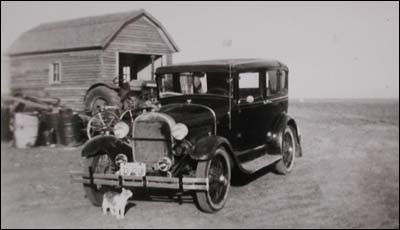
Elgie Unruh photographed his Model A outside the family's garage in the 1940s. The building looked tired even then on the featureless landscape. [November 10] For at least three decades before it was brought to earth, the garage on my grandparents' farm northwest of Pawnee Rock sat empty.
Dried by the wind and sun, the garage for me had only two surviving smells, dust and grease. The aroma rose from the dirt floor, which was saturated by crankcase drips and errant squirts from the grease gun. Farm dust -- loess deposited on tens of thousands of windy days -- collected on the counter and grew up in drifts in the corners; sometimes rain blew in from the south and made little balls of mud. Swallows lived the garage, fixing their mud-built nests near the rafters, and their droppings decorated the cabinet door. Not much else was here; few rats or snakes, no moths or praying mantises found food or shelter inside these walls. Decades earlier, everything in the garage was used: The carpenter's apron, the drill press, the cabinet. Or reused: The paint can, the coffee can, the scraps of lumber, the loaf tray that held nails and bolts. In my childhood, and I suppose it was like that in every year since the farm began to slide into old age, summer weeds grew high in the wide space between the garage and the wooden granary to the west, and we cousins tunneled through them. We preteens and teens ignored the garage. It was safe, but it wasn't interesting in the way the barn was. It doesn't take much to imagine the days when this garage was a center of activity, and bantering brothers turned their hands to hammering and painting and turning the drill press. My dad's generation had three boys, and there were automobiles and trucks and tractors to keep running. In the days of my great-grandparents, who moved to this piece of land more than a hundred years ago, leather tack for the horses would have been repaired here. This was a working garage, a mechanic's shed. The garage, I suspect, began to lose its value when the three brothers and their sister moved off the farm and only Grandpa and then Laramie, one of the sons, handled the planting and cattle. The barn, having lost its horses, was needed less for its original use and provided better protection for the grandparents' white Chevy Impala, so the barn became the garage for the car as well as the combine -- and there was one less building that required attention as our grandparents aged. The farm's current owner kept some of the buildings but took down the garage, along with the granary and the house. The garage had done its job and nothing more, and when it came time to go, it went. The old garage can be remembered, however, for the labor that went into its construction and for the work that was performed inside it. That garage -- an honest building on a small farm in a corner of a township on the edge of the Dust Bowl -- has meant something in particular to each member of my family, and we carry the garage with us into the future. Grasses
[November 9] Human artifacts come and go; fenceposts and wires rust away over the years and glass falls to the dust. Our homes and towns arise and, as we see in rural Kansas, eventually go empty and sublimate to the wind. In the land of wind, grasses sway with the breeze. After fires scorch the land, grasses' deep roots bring life back to the surface. Those roots hold the ground together and in times of drought search deeply for water. The grasses endure. More than any landowner, they are the stewards and inheritors of Kansas. Bolts from the black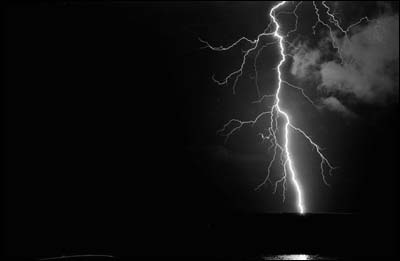
Lightning over Barton or Pawnee County, Kansas. [November 8] Sometimes folks just have to stand outside with their mouths open. Maybe it's a tornado or a big fire that sucks up all our attention. As often as not, for me it's lightning. I've been a night creature for as long as I can remember, and I used to drive around a lot after sunset in the summers as I grew up. My excuse was that I could take photos in Larned for the Tiller or for the Hays Daily News, but I think I just liked the feel of the air blowing through my open window. That habit of mine put me out in front of many lightning shows. There was heat lightning, always a long way off. There were thunderstorms marching in from the southwest, long bolts running between heaven and earth. There were the ominous bolts that illuminated the towering clouds from within, and in the seconds that followed I scanned my flash memory for funnels that had been backlighted. I would put my camera -- at various times a Ricoh or Pentax Spotmatic F or Olympus OM-1 -- on a cheap Sears tripod and set the shutter to stay open until several bolts had flashed across the countryside. Then I'd run home and develop my roll of Tri-X. This was a stupid thing to do. I stood with a three-legged lightning rod on Barton County's treeless hilltops -- I especially liked the dirt road adjoinging the Mennonite Cemetery -- next to a car, and now I have learned that lightning can flash from a storm to touch some fool many miles distant. I'm lucky to be alive, or at least not toasted. On the other hand, I have some magnificent trophies. Furthermore, I have indulged my desire to watch lightning at play, and it has given me a sense of how the storms are systems far more complex than a child's drawing of a lightning bolt being flung to the ground. And the plains storms are really big. Much bigger than a teenager standing alone before God and Nature. At least I was smart enough to know that when the fresh breeze arrives, it's time to pack up. Ditch kitty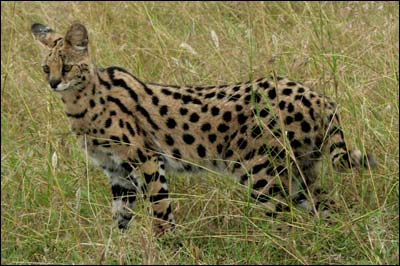
[November 7] I was driving in to work yesterday around noon, and I turned my head to look for traffic coming down a ramp onto Alaska Highway 1. A car had stopped, and a teenager was scrambling down into the snowy ditch. Right ahead of him was a cat. He was chasing a big orange cat, which I guessed stood about knee high to me and was covered with large spots, and it was moving smartly back up the highway. Leopard? Jaguar? My mind ran through its rather short list of wild cat species. Despite having a name that means "lion" in several languages, I'm not a cat fancier. I settled on ocelot. I pulled over at the next interchange and called the newspaper's photo editor with the news. "That's the weirdest tip I've ever gotten," he said, adding an adjective that I am omitting. But there it was in real life, a big cat on the run far from where it should have been stalking rodents. It was a magical moment, one of those that appears out of nowhere and leaves a guy smiling and feeling lucky. It was even better than having a pheasant run alongside the car north of Pawnee Rock, or surprising a possum in the back yard. No one could have expected this. The state wildlife biologist, after being questioned by a reporter, sent out a fax saying that the cat was not an ocelot but a serval, a pouncing cat that's native to the plains of Africa. The fax "said that Leon is not crazy," the photo editor said. The serval had been seen in several places around town, apparently moving along the coast and creeks and, as it would turn out, avoiding our photographer. The biologist didn't hold out much hope for the serval unless it finds its way back to the home from which it escaped. The cold, and the lack of wintertime rodents, will do it in. I hope it survives. It's not my cat, but now in a way it is. Wayne Becker, a Pawnee Rock connection[November 7] Wayne Becker, a son of Harold and Lois Gilbert Becker, the first couple known to be married on Pawnee Rock, has died in Great Bend. He was 71. (Obituary) Pawnee Rock voted for McCain[November 6] Pawnee Rock city and township have 269 registered voters, and 164 of them cast ballots in Tuesday's election. That's 61 percent. The city and township make up one precinct, and the Election Day voting was done at the depot. • For president, the McCain-Palin (R) ticket collected 111 votes (68 percent), beating Obama-Biden (D) 45 votes (28 percent), Nader-Gonzalez (Ind) 4 votes (2 percent), Barr-Root (Lib) 2 votes (1 percent), and a write-in 1 vote (1 percent). Kansans as a whole voted 57 percent for McCain and 41 percent for Obama. • For U.S. senator, incumbent Pat Roberts (R) got 103 votes in Pawnee Rock, Jim Slattery (D) 45, Joseph Martin (Ref) 8, and Randall Hodgkinson (Lib) 6. • For U.S. representative, first district, incumbent Jerry Moran (R) won with 127 votes, over James Bordonaro (D) 22, Kathleen Burton (Ref) 7, and Jack Warner (Lib) 4. • For state representative, 112th district, incumbent Bill Wolf (R) had 98 votes to Marty Kennan's (D) 65. • For sheriff, Greg Armstrong (Ind) beat incumbent Buck Causey (R) 81 votes to 76. Uncontested races were on the ballot too. • State senator, 33rd district: Ruth Teichman (R) got 139 votes. • District judge, 20th district, division 2: Hannelore Kitts (R), 131 votes. • District judge, 20th district, division 3: Mike Keeley (D), 142 votes. • County clerk: Donna Zimmerman (D), 149 votes. • County treasurer: Kevin Wondra (R), 141 votes. • Register of deeds: Marcia Johnson (R), 143 votes. • County attorney: Douglas Matthews (R), 130 votes. In local races, we had these results: • Pawnee Rock Township trustee: Dale Dirks (R), 152 votes. • Pawnee Rock Township treasurer: Scott Loving (R), 149 votes. Our thanks go to Barton County Clerk Donna Zimmerman for sending us the results. Just in case you're still interested in voting . . . The New Yorker magazine ran this great piece about the history of voting: Rock, Paper, Scissors. Township elections[November 4] Dale Dirks, a Republican, was elected treasurer of Pawnee Rock Township. He collected all 152 votes cast in the race. Scott Loving, also a Republican, was elected township treasurer, gathering all 149 votes cast in the race. I have a request in to our friend Donna Zimmerman, the county clerk, for the complete voting results of Pawnee Rock city and township. I'll pass them along when they arrive. I voted today
My wife votes, and Nik learns. [November 4] My wife and I took the boys out of homeschool today when we went to the poll in the Lions Club building near our house. The boys can read about elections all the way back to Washington, but a civics lesson in person will mean a lot more. I showed the boys the mechanics of voting: How we hand our registration card to the poll worker at the table and sign the book, and how the fellow next to her gives us a ballot. I took Sam into the booth and my wife took Nik, and when we were done we let the boys run our secret ballots into the scanner.
The guy running the ballot scanner said it had been busy early in the day, and there had been a steady flow by the time we arrived shortly before noon. (I was voter No. 616, and that's a good turnout already in our precinct.) He expected the rush to start when people arrive after work. Our polls are open until 8 p.m., or 11 p.m. Pawnee Rock time. (Sarah Palin and her black-SUV entourage flew through town early today on her way to Wasilla, where she voted, got coffee, and then scurried back to the Anchorage airport to fly to Arizona.) This day is a big deal for the boys, and it should be. When I was a boy in Pawnee Rock, I watched the voters come and go all day when the election was held in the old city hall, and I was amazed by the thought of each of the adult's votes being added to the state total and then to the national total. In the middle of Kansas, it was easy to feel forgotten. But there were the adults of our town, standing up for their share of the country.
Our precinct's polling place, in Eagle River, Alaska. Vote for America[November 4] Today is Democracy's holiest day. No one knows how big the democratic wave will be, but this is the day when we, the people, cleanse the temple. This is the day when we can announce that we, as a people, do value education and economic justice and that we do want our military power and diplomacy wielded wisely. On this day we can declare that we believe that government can be used for good -- to protect us from poisoned food and water and air as well as from the enemies the current administration created so deftly. This is the day we can officially stop living in the shadow of those who breed fear and distrust and who hold hypocrisy before themselves as a torch. We -- you and I and our cousins' neighbors -- are the "real America," and today we as a nation can reclaim the flag from those who have pulled it down to wrap around themselves. We could vote for the government that we deserve. Or, we can vote for the government that expresses our best hopes. We can vote for a real morning in America. Cheryl Unruh, radio star[November 4] Cheryl Unruh, who grew up in our hometown and who I like to call the Voice of the Flint Hills, has another radio segment scheduled for this week on Kansas Public Radio. (Here's more.) In addition, she received an award from the Kansas Association of Broadcasters for her Mother's Day tribute. Way to go, Sis. The magic of an audience
[November 3] The Pawnee Rock Lions Club chapter has done a lot in Pawnee Rock over the years since it was founded in 1949. There have been innumerable candy sales, visits from Santa, holiday coffee stops, and so forth. One of my favorite events was a magic show brought to town as a fund-raiser. The magician was Rex and his assistant was his wife, Shari. Dressed on ostentatious clothing, they performed on the stage of the high school gym, and the audience was allowed to sit as close as the free-throw line -- about 25 feet from the slight of hand. At that range, the sleight could have been fairly ham-handed and we wouldn't have known the difference. A photo I made of the audience shows a full house (bigger view). There are grade-schoolers at the far edge of their attention span, high schoolers sitting as close as they can to each other without being teased, the fifth-grade teacher (Beulah White), a preacher (Gerhard Peters, who I think was the club president), and a nice selection of parents and grandparents. Afterward, there was ice cream in the cafeteria. Those of us who have moved on to the big city don't get much of this camaraderie anymore. Our neighborhood school might have such an event, or a church might, but this magic show was an event for the whole community, all 450 of us and our friends. People dressed up for it and came from out of town. I read a quote a few minutes ago by Marcel Proust: "The only paradise is paradise lost." I hate to think that this kind of event is lost to us. Maybe it's lost only to me, and that's why it seems like a kind of paradise. The magic show was all right. Years later, however, I get much more entertainment from the audience. Durable goods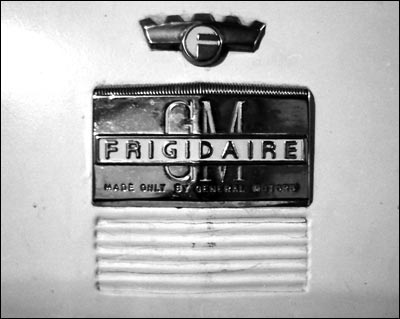
The door emblem of our Frigidaire, made only by General Motors. [November 2] Yesterday my wife was chasing down a drip under the kitchen sink and ended up doing some actual plumbing. That involved taking the ten-year-old dishwasher out -- its heater element gave up the ghost a few months ago -- by disconnecting its lifelines and lifting it over the hardwood floor she installed. We have a fair division of labor in our house. We each do what we're best suited for. My share of the labor? I took the dishwasher to the dump. It cost $5 to leave it there among its frost-covered cousins, its hose tucked under like a whipped puppy's tail. My wife went into town later and bought a new dishwasher. It's a lovely white box with adjustable shelves and all the stemware holders and other doodads the rest of you probably already know about. But so much of it is plastic. Even the insulation is slabs of plastic mesh. Now, to me, a kitchen appliance is not trustworthy unless it's made of enameled metal. I grew up with a metal stove with metal knobs, a metal refrigerator, and a metal sink. Our refigerator, a Frigidaire, was so heavy it could have been the offspring of two Buicks. Some folks in town had not only avocado or harvest gold metal-fronted dishwashers but also trash compactors. There was a party at the Countrymans' house once after they installed one, and we all stood around and watched cans and boxes get squished. I did a share of the dishwashing and compacting (with my right foot) at home, and I burned that trash in a metal barrel in the back yard. For the benefit of free meals at school I spent many hours at the kitchen's steel sinks and sanitizer. Things in those days were made of metal, and they lasted and could be repaired. It's just the way it was. Our new dishwasher will use less electricity than our old one, and it will no doubt save us some money over what we've been doing, which is washing the dishes by hand in gas-heated water. In other words, the dishwasher is a welcome addition. Still, I consider myself lucky to have been acquainted with appliances that truly were durable goods, the kind that you grow up with and that are still there when you take the kids over to see Grandpa and Grandma. Sports we live for[November 1] Ding dong. What's this left on the front porch? Why, it's the remainder of the Sunflower State's college football season. Isn't that cute? Those Jayhawks and Wildcats are playing each other again this morning. When the season's over, will one of them have a bowl game? Probably. Look, there's a note. It says that the men's basketball season starts on November 14 for the Cats and on November 16 for the Hawks, and not a weekend too soon. The dogs within us[November 1] Several readers wrote yesterday to ask whether my Halloween posting about one man's unfortunate night along the Arkansas was a true story. It could have been true. I think the guy -- if he was real -- was convinced the story was true. I could relate.
Beer-drunk 25-year-olds with four-wheelers roam along the river, especially on weekend nights, and I would suspect that some of society's armed malcontents farm marijuana within our riverine biosphere. They can generally be avoided. You can sit there at night, having walked far from the road, with your back to a cottonwood, bug spray on your face, and a shotgun across your lap. Beautiful summer can surround you, and the gurgle of the river can soothe your spirit. But you know that, should you rest your eyes, aliens could easily surround you and have themselves a feast. Jesus, or the devil, might arrive; considering what you keep a secret, are you ready right now for eternity? A sliver of insanity -- you know you have one -- might finally reach your spinal cord, and all you would need to hear is the snap of a twig behind you. These are the dogs that hunt along our river. You can fear them, or you can run with them. Was the old man in Waxy's Cafe telling the truth? If you asked to see his scars, would you show him yours? OK, really. The Arkansas River lowlands are a great place to fish and look for wildlife. There is nothing to be afraid of. Any demons you find along the river are those you carry in with you. Not that you have any, of course. Just be home by dark. |
Sell itAdvertise here to an audience that's already interested in Pawnee Rock: Or tell someone happy birthday. Advertise on PawneeRock.org. |
|
|
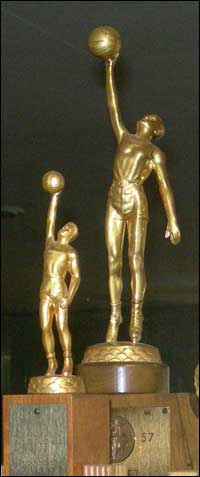 You saluted the flag on the east wall and cheered the Braves as they were introduced. The games weren't very long, four quarters of eight minutes, but they were packed with action. If you were a player, you lived every second at full speed.
You saluted the flag on the east wall and cheered the Braves as they were introduced. The games weren't very long, four quarters of eight minutes, but they were packed with action. If you were a player, you lived every second at full speed.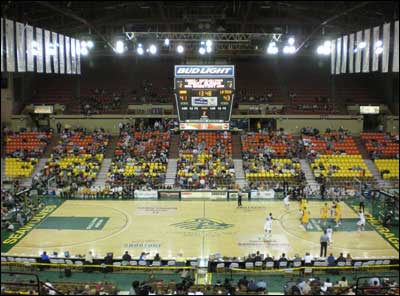
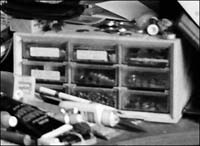 On a crowded shelf over my pillow rested a nine-drawer plastic cabinet that other people might have put in a sewing room or woodshop to hold tacks or pins or yellow tape measures. This was my "dealie cabinet," although I confess that I have never known whether it might better be spelled "dealy" or "dealey." It was where I kept my treasures.
On a crowded shelf over my pillow rested a nine-drawer plastic cabinet that other people might have put in a sewing room or woodshop to hold tacks or pins or yellow tape measures. This was my "dealie cabinet," although I confess that I have never known whether it might better be spelled "dealy" or "dealey." It was where I kept my treasures.
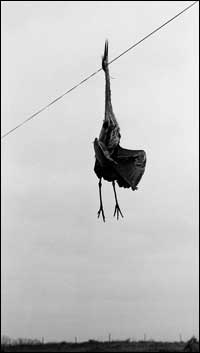 When the geese come by at night it's difficult to see them, but sometimes the white fronts of the Canada and white-fronted geese catch the moonlight and we're rewarded with a spectacular and poetic memory.
When the geese come by at night it's difficult to see them, but sometimes the white fronts of the Canada and white-fronted geese catch the moonlight and we're rewarded with a spectacular and poetic memory.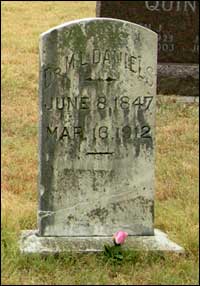 [November 23] There's not much left of Dr. M.L. Daniels' legacy in Pawnee Rock except a photograph of him at his office and a grave marker. The
[November 23] There's not much left of Dr. M.L. Daniels' legacy in Pawnee Rock except a photograph of him at his office and a grave marker. The  He came to Kansas from Virginia, but was born in Cumberland County, Pennsylvania, September 20, 1841. His early youth was spent in Frederick County of the Old Dominion. His grandfather, Michael Wise, was a Pennsylvania farmer and died near Carlisle, that state. Among his children were Samuel, Michael, Caroline, who married Comer Albin; Mary, whose first husband was Mr. Long and the second, Daniel Brindle; Annie, who married John Childs; and Catherine, who married John Yowell.
He came to Kansas from Virginia, but was born in Cumberland County, Pennsylvania, September 20, 1841. His early youth was spent in Frederick County of the Old Dominion. His grandfather, Michael Wise, was a Pennsylvania farmer and died near Carlisle, that state. Among his children were Samuel, Michael, Caroline, who married Comer Albin; Mary, whose first husband was Mr. Long and the second, Daniel Brindle; Annie, who married John Childs; and Catherine, who married John Yowell.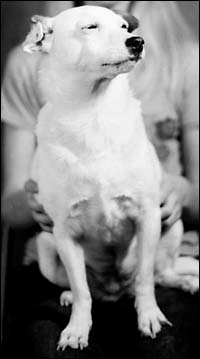 Patches (photographed here as a mature dog) lived for 16 or so years and as far as I know she never ran off again. But then, in Pawnee Rock all dogs ran free and she seemed happy enough to go no farther alone than the street, where she slept in the warm sand.
Patches (photographed here as a mature dog) lived for 16 or so years and as far as I know she never ran off again. But then, in Pawnee Rock all dogs ran free and she seemed happy enough to go no farther alone than the street, where she slept in the warm sand. My favorite installation of backyard art, however, was made not of wood and wings but of metal and wind.
My favorite installation of backyard art, however, was made not of wood and wings but of metal and wind.
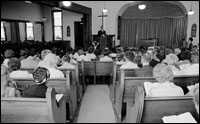
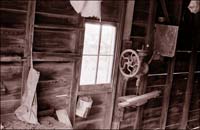
 Both boys proudly received their "I voted today!" stickers.
Both boys proudly received their "I voted today!" stickers.
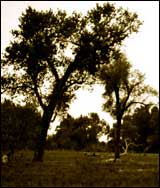 There have been many nights when I've been frightened out there south and east of Pawnee Rock. Not necessarily in a run-home-to-mama way, but scared to the point of not being able to sleep. As anyone who has camped along the river knows, there are indeed wild dogs -- you can see their prints in the sand -- and other unsavory creatures, including skunks, opossums, and raccoons, all of which have sharp teeth. In addition, raccoons poop in the joints of trees so you might not want to climb a tree for safety.
There have been many nights when I've been frightened out there south and east of Pawnee Rock. Not necessarily in a run-home-to-mama way, but scared to the point of not being able to sleep. As anyone who has camped along the river knows, there are indeed wild dogs -- you can see their prints in the sand -- and other unsavory creatures, including skunks, opossums, and raccoons, all of which have sharp teeth. In addition, raccoons poop in the joints of trees so you might not want to climb a tree for safety.